This week we’re asking if it’s time to shift customer interaction away from volume and start investing in quality, what consistency has to do with trust in branding, and what you need to know when choosing a content management system.
Candice, Managing Director
Measuring customer lifetime value
When building your marketing strategies, business find themselves asking how much does it, or how much should it cost to acquire a new customer? But more importantly you should be asking yourself what is the customer lifetime value (CLV) to determine what is reasonable to spend to acquire them?
Why? Well it’s a quicker path to increasing revenue for your business, allowing your business to be more profitable and of course helps to justify what you should be spending on acquiring new customers.
Would you believe that it costs five times more to acquire a new customer than it does to maintain a current customer, and in today’s world, businesses are currently investing in nearly 80% of their digital marketing budgets on customer acquisition, with 42% of businesses not even able to measure customer lifetime value (CLV).
It might be time to make a significant shift away from the traditional marketing focus on volume and start investing in the quality of every customer interaction. How do they interact with your business and your brand across devices and different channels? How frequently do they use your service or purchase your products and which of these do they require the most?
Once you look at your own customer data, you can determine the most effective marketing strategies to increase their loyalty, drive more repetitive business and acquire more customers with similar behavioural and demographic profiles closest to those who are driving the most revenue for you.
Sian, Creative Strategist
Why trustworthy brands are consistent brands
Brand identity design doesn’t make the headlines very often—but when it does, it’s invariably negative news. This time, it’s the turn of the NHS to be ridiculed for “messing around with stupid logos”.
Despite it being publicly funded, the NHS is still a brand, meaning it has a team they pay to work on the visual, verbal, interactive, and sensorial communication of the organisation. And, amongst record high waiting times in A&E, staff shortages, a lack of beds, and the seemingly never ending cull of specialist units, you can sort of see why people are so angry about a new set of brand guidelines which will cost money to roll out.
But this is dangerous thinking. Design isn’t a luxury, nor is it purely for aesthetic reasons. A lot of media attention has focused on the requirement for the NHS logo to be moved above the name of each trust. They fail to mention that the guidelines make the use of the logo compulsory, and the power that visual consistency can have.
Consistency = less confusion due to it being easier to identify belonging, therefore implying legitimacy, and in turn increasing trust.
An example of the scale of this power of consistency is clear when you look at the measures some organisations—especially when dealing with saving lives—take to enforce guidelines such as the British Red Cross:
“The emblem of a red cross with arms of equal length on a white background is the visible sign of protection under the 1949 Geneva Conventions. As such, it is the emblem of the armed forces’ medical services and its use is controlled by governments. It is first and foremost a symbol of neutral protection in wartime. To be effective, it must be understood and completely trusted. Unauthorised use may be a criminal offence.”
Not only does consistency imply legitimacy to increase trust and save lives, it can also save money. The UK government’s award winning gov.uk website streamlined an overwhelming number of sites into one, making processes more convenient, easier to navigate, and more trustworthy (and therefore more likely to be used)—and saved taxpayers £61.5 million in 2015.
Of course, having a consistent identity is by no means on the same level as funding more beds and more staff. But arguments about this being a waste of money undermine what design can do: clearly communicate, solve complex problems, enhance trust, and save money in the long run.
Chris, Head of Digital
A Ferrari or a Fiat 500?
There is something you have to decide before making your decision. Will I ever get to use the Ferrari to its majestic potential living in the city, or will it just sit in the garage most days when the Fiat 500 would be perfect in and out of traffic every morning?
The same applies to choosing a content management system (CMS).
Too many companies select the CMS they want to use to manage their website before deciding on what they need it to do.
Does your website sell products online or is it a service based website that displays content in multiple languages? These are the type of questions that need to be answer before doing any research into the best CMS for you.
The other mistake we see a lot is going with a CMS that does not allow you to future proof your online business model. As you would grow out of an office when your company expands and evolves, the same applies to the CMS you choose. You have to ensure it will look after your future digital strategy requirements.
The beautiful thing about websites is that unlike cars, if you only need the Fiat 500 for your requirements, we will still make your website look like a Ferrari and no one will ever know.



